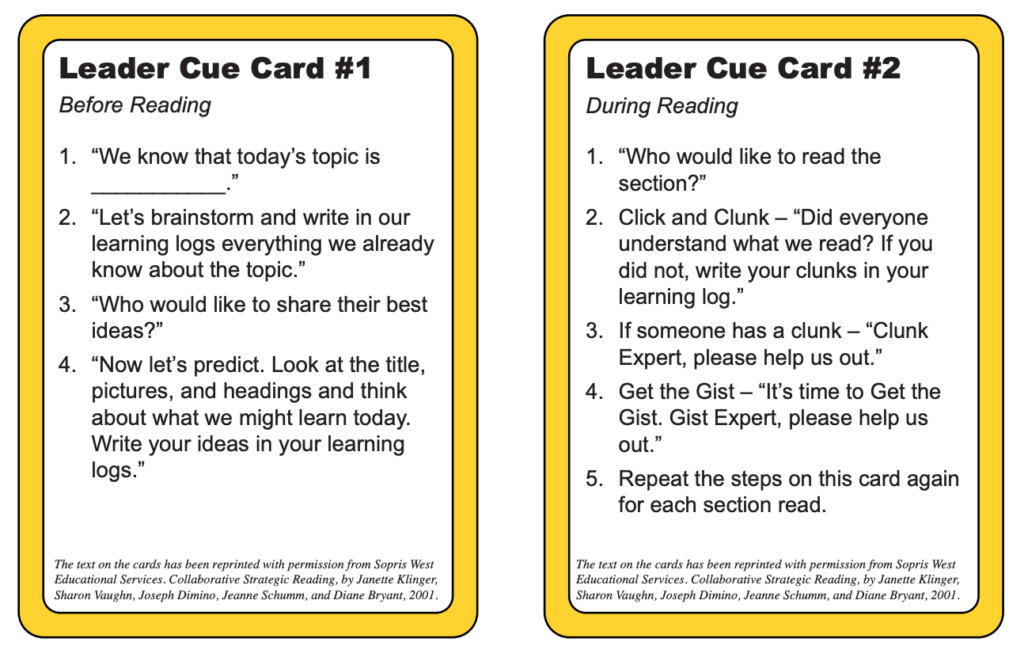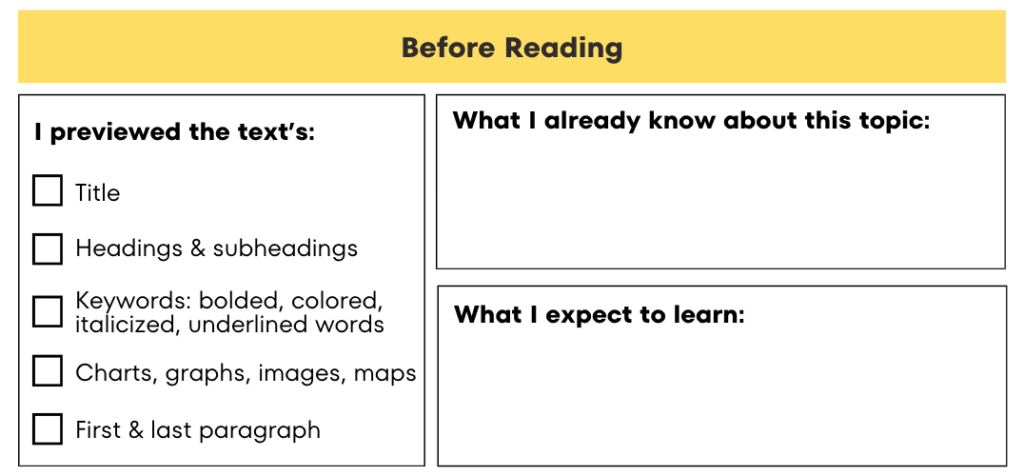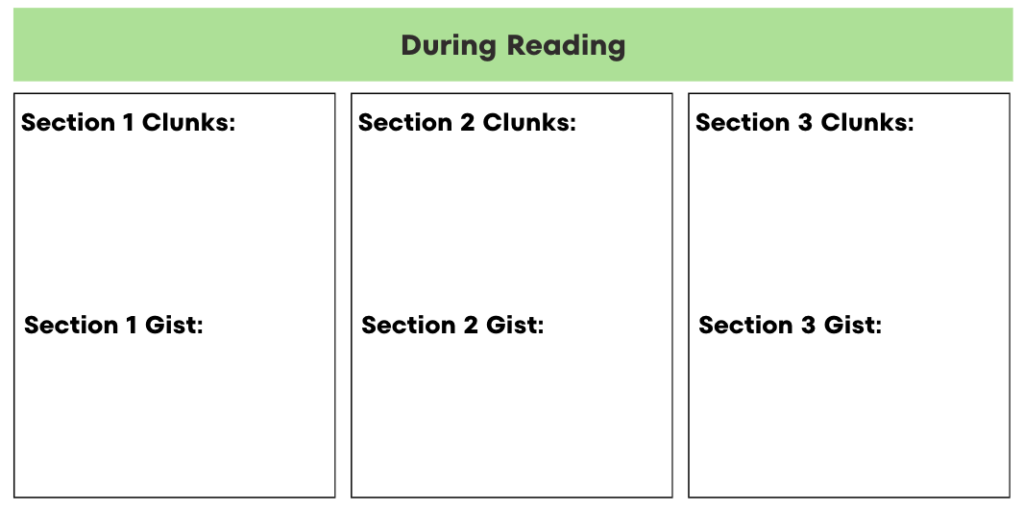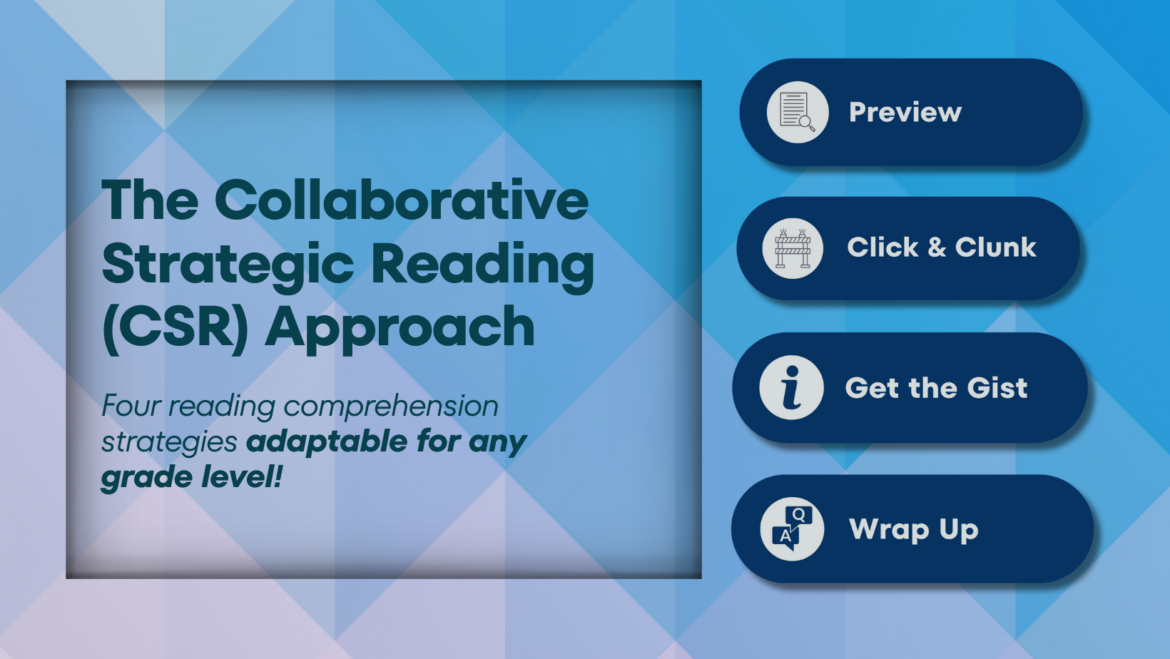What is CSR?
CSR is a cooperative learning approach that can be used in any grade level and with students of varied reading levels and abilities. It’s meant to primarily boost reading comprehension when it comes to expository and nonfiction texts, like for science and social studies. However, it can be used for narrative texts as well. CSR is an evidence-based approach where students work through the text together in small groups using four reading comprehension strategies before, during, and after reading:
- Preview (before reading)
- Click and Clunk (during reading)
- Get the Gist (during reading)
- Wrap It Up (after reading)

Getting Started with CSR
It’s important to note that before students begin using the CSR process in a group, they will need to learn and practice the four strategies on their own. Using a Gradual Release of Responsibility approach, you can introduce each reading comprehension strategy in a separate mini-lesson, modeling it for the class. Then, students can practice the strategy with a partner or in a small group. Once they’ve got the strategy with guided support, they can begin to practice it on their own until they are ready to use the strategy cooperatively.
Materials Needed for CSR:
- Learning Log: A graphic organizer where students make notes throughout the process.
- Cue Cards: Prompts for the different roles in the groups to use.
- Clunk Cards: Four “fix-up” strategies for students to use if they reach a roadblock.
- Timer (optional)
Here are some great free CSR materials, complete with cue cards, clunk cards, and a learning log, available for download from IRIS Center at Vanderbilt University. Also, they provide role cards with explanations for each student’s role in the group.

Student Roles:
Each group member is given a specific role, so all students in the group are responsible for a task. Potential student roles (depending on group sizes) are:
- Leader
- Gist Expert
- Announcer
- Timekeeper
- Clunk Expert
- Encourager
- Reporter
Let’s take a more in-depth look at the four reading comprehension strategies that make up this approach!
The Four Reading Comprehension Strategies
1. Preview

During the text preview, students work together for a short period to look at important text features like headings, subheadings, bolded words, charts, graphs, images, etc. The purpose of the preview is to activate students’ prior knowledge and get them to ask questions, make predictions, and boost their curiosity on the topic. During this time, the teacher can walk around and ask each group about their observations, predictions, and questions regarding the text. Helpful prompts for students (that can be included in a learning log graphic organizer) might be:
- What knowledge do you already have on this topic?
- What do you expect or hope to learn?
- What questions do you have on this topic?
IRIS Center suggests giving students 12 minutes for this reading comprehension strategy. Once they’ve shared with the group and completed the “Preview” section of the learning log, it’s time to share with the class.
2. Click and Clunk

During this part of CSR, students begin reading a section of the text and monitoring their comprehension. This means students are using metacognition (thinking about thinking) to check their understanding as they move through the text. “Clicks” are parts of the text that the readers understand. “Clunks” are aspects of the text that readers find to be roadblocks to understanding, like unknown words or concepts.
Monitoring comprehension builds confidence and independence when it comes to reading. Working on this in a group can push students who may not usually stop to explore “clunks” to do so, resulting in increased reading comprehension. After reading a pre-determined section (a paragraph, a few paragraphs, or a page, for example), the students go over clicks and clunks. After identifying the “clunks”, the Clunk Expert can guide the group in the following reading comprehension strategies:
- Reread the sentence with the clunk and look for key ideas to help you figure out the word. Think about what makes sense.
- Reread the sentences before and after the clunk, looking for clues.
- Look for a prefix, root word, or suffix that might help.
“Toward a Humanistic Instruction: Collaborative Strategic Reading Approach and EFL Learners’ Reading Comprehension”
- Break the word apart and look for smaller words that you know.
3. Get the Gist
After previewing the text, identifying clicks and clunks, and working through clunks, students begin to identify the main ideas of the predetermined sections of text together to demonstrate reading comprehension. This is a summarizing activity that gets students to restate what they read in their own words (IRIS Center suggests 10 or fewer words) without getting too detailed. CALIReads suggests students follow three steps:
- Name the who or the what.
- Tell the most important thing about the who or the what.
- Say it in about 10 words.
Get the Gist is a great retelling reading comprehension strategy that allows students to recall important information from the text and summarize it, which solidifies their learning.
4. Wrap Up

In this final step, students work with their group to come up with questions and correlating answers about the reading. They can think about “who, what, where, when, why, and how,” and they can speculate as to what questions a teacher might ask about the text. If needed, question stems can help prompt students to form deeper questions. After noting questions in their learning logs, they share them with their group and answer the questions together, writing down and reviewing what they learned.

This cooperative learning approach to content-based reading can boost comprehension of everything from textbook chapters to nonfiction articles and more. Can you picture using CSR in your classroom? If you introduce these strategies to your students, let us know how it goes! We’d love to hear about your results.

